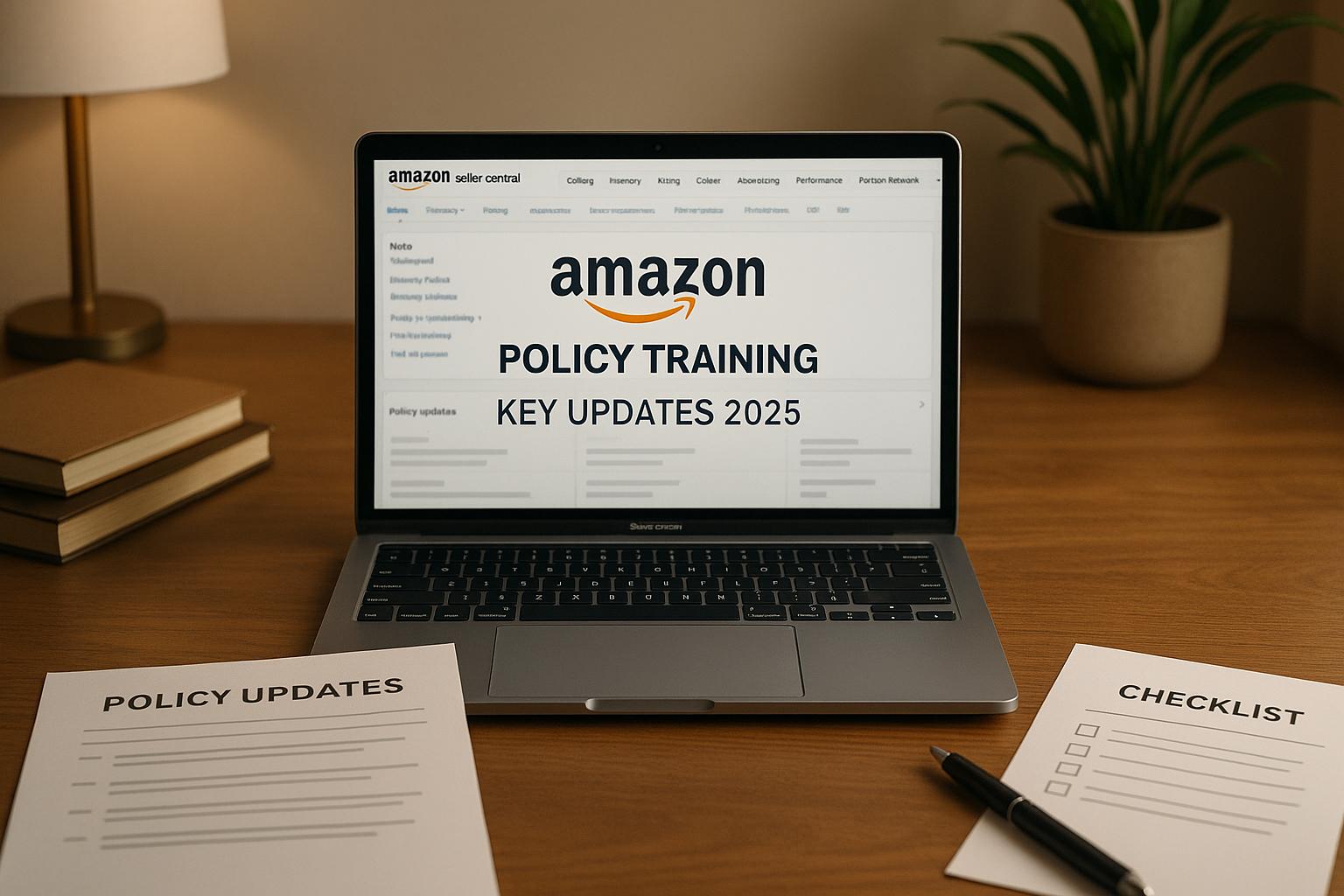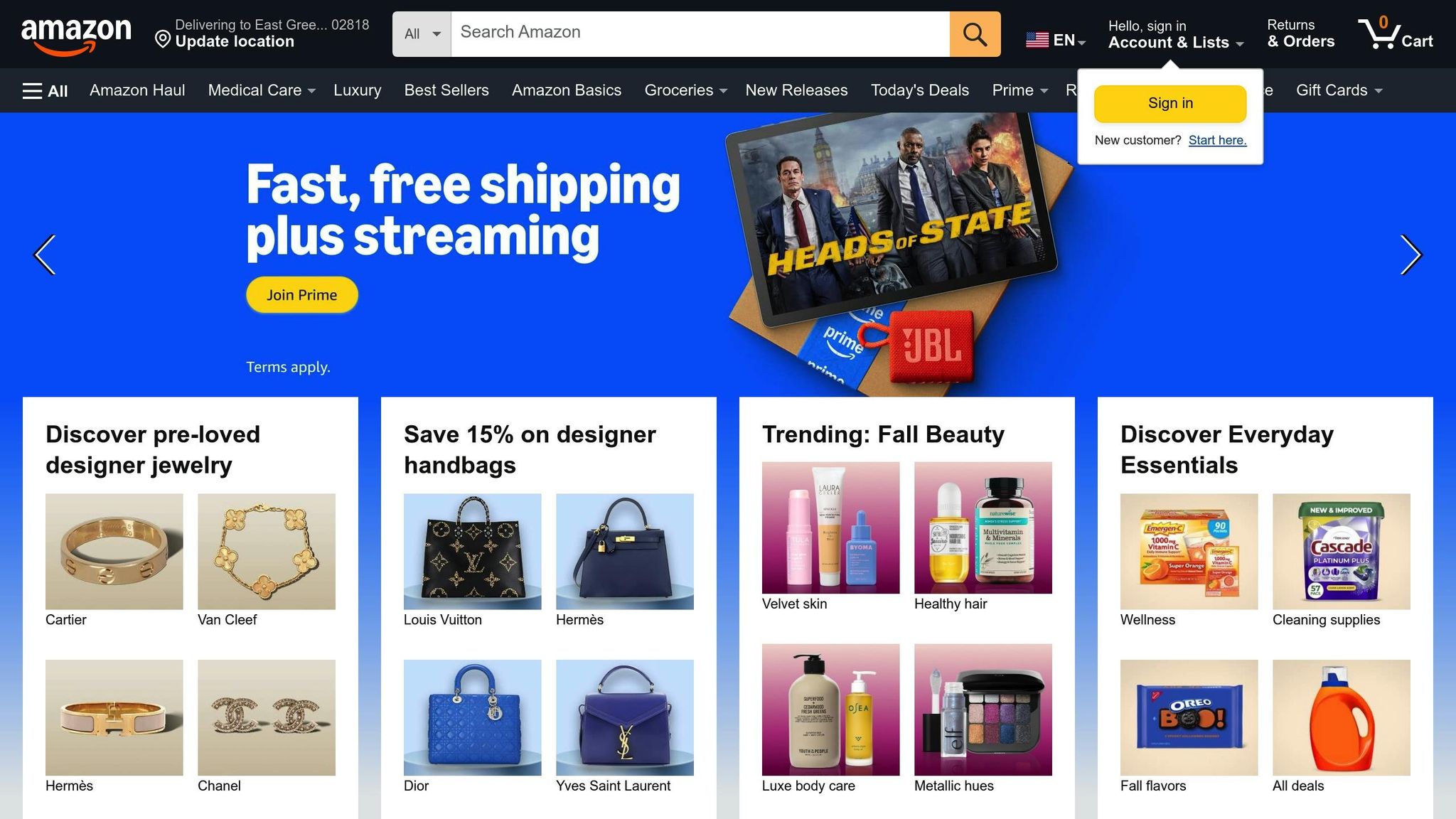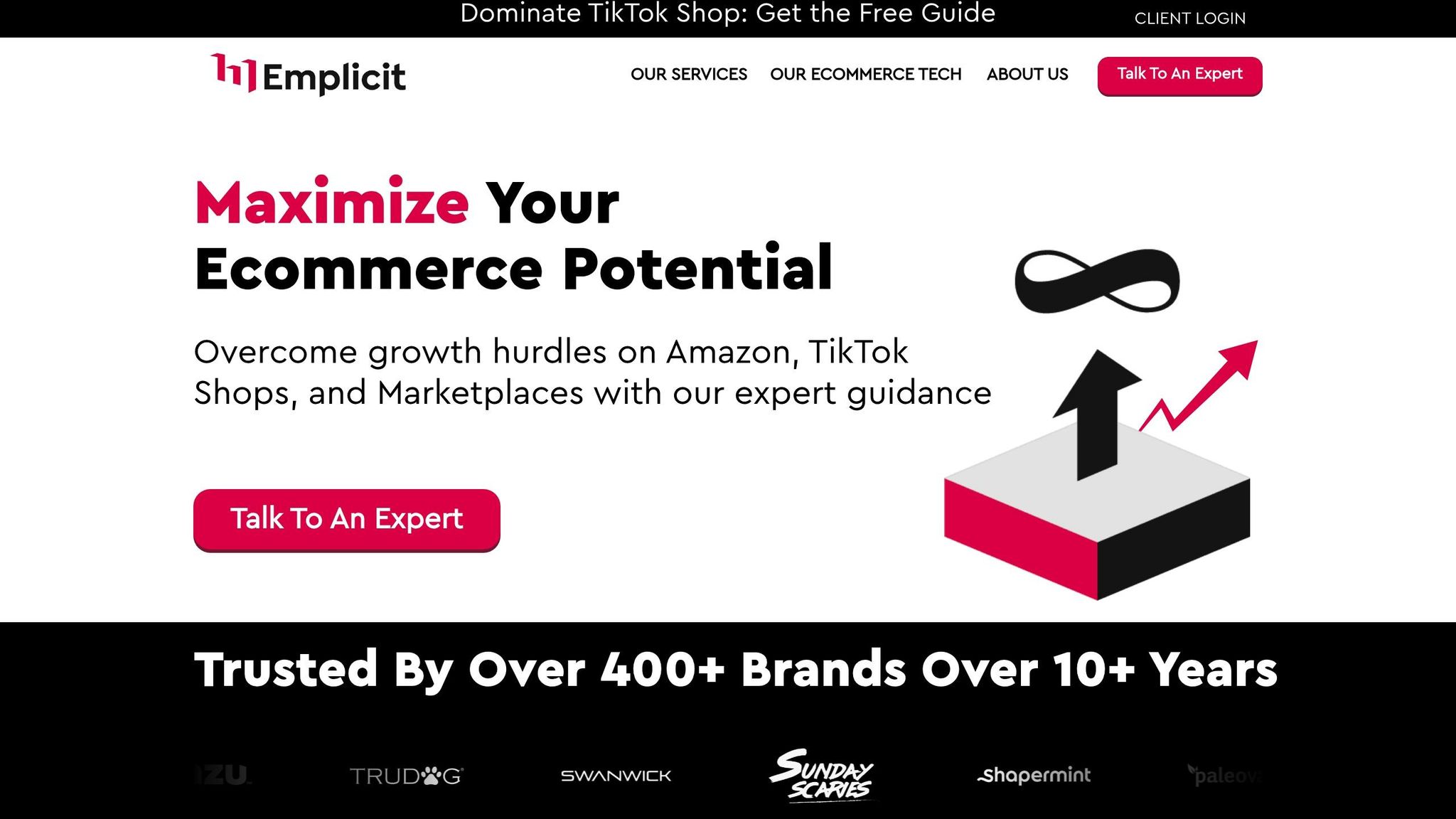
Amazon has rolled out new policies for 2025 that sellers need to follow to maintain compliance and avoid disruptions. Key changes include stricter product authentication, automated tax reporting, updated inventory management rules, tighter customer communication monitoring, and revised return processing guidelines. These updates aim to ensure marketplace integrity and better align with regulatory standards.
What sellers need to know:
- Who is affected? All sellers, especially those in regulated categories like electronics, health, and automotive.
- What’s new? Enhanced documentation requirements, automated compliance systems, and stricter enforcement timelines.
- When do changes apply? Immediately for new listings; existing listings must comply by specified deadlines.
To stay compliant, sellers should regularly check Amazon’s Seller Central, complete required training, and keep all verification documents ready. For complex cases, expert services like Emplicit can assist with account health management and compliance strategies.
Bottom line: Staying informed and acting quickly on these updates will help protect your account and support business growth.
Amazon‘s New Rules for 2025: What Sellers Must Know NOW!

What Changed in Amazon’s 2025 Policies
Amazon’s updates for 2025 bring tighter compliance measures through improved verification processes, stricter documentation requirements, and automated monitoring systems. These updates set the stage for more detailed changes, which are outlined below.
Main Policy Changes for Sellers
Amazon has introduced several new guidelines for sellers to ensure stricter adherence to its standards:
- Enhanced Product Authentication: Sellers must now provide additional documentation, such as supply chain records or certifications, to verify that their products meet quality standards.
- Automated Tax Reporting: Tax compliance processes are now automated, requiring sellers to integrate their systems with Amazon’s reporting tools.
- Inventory Management Updates: New rules enforce optimal stock levels, with adjustments to storage fees for items held beyond recommended timeframes.
- Customer Communication Monitoring: All customer interactions must follow stricter guidelines, which are now automatically monitored for compliance.
- Return Processing Changes: Sellers must respond promptly to return requests and follow specific protocols for handling returns, especially for certain categories.
Product Categories Most Affected by Changes
Some product categories have been impacted more significantly due to additional regulatory and safety requirements. For example:
- Electronics: Sellers must provide extra compliance documentation to meet updated standards.
- Health and Personal Care: Enhanced safety criteria now apply to these products.
- Automotive Parts, Home and Garden, and Clothing: Specialized guidelines have been introduced for these categories, requiring sellers to carefully review Amazon’s updated rules.
Sellers in these areas should prioritize reviewing the latest official guidelines to avoid disruptions.
When Sellers Must Follow New Rules
The timing of these changes is crucial for maintaining compliance. Here’s what sellers need to know:
- New Listings: The updated policies apply immediately to all new product listings.
- Existing Listings: Sellers must update existing listings within the deadlines outlined in Amazon’s official communications.
- Account Reviews and Training: Regular account reviews will ensure compliance, and seller representatives are required to complete updated training modules to stay informed about the new policies.
For specific deadlines and further instructions, sellers should refer to Amazon’s official policy resources. Staying proactive with these updates helps protect account health and ensures eligibility for premium programs.
How to Follow Amazon’s New Policy Rules
To keep up with Amazon’s latest policy changes, it’s crucial to stay updated and adjust your practices as needed. With the 2025 updates, make sure to regularly check Seller Central for guidance and refresh your account settings and product listings accordingly. Here’s how you can stay compliant:
How to Update Product Listings and Account Settings
Log in to Seller Central and pay attention to any compliance notifications. Follow the on-screen instructions to upload necessary documents, update your tax details, and adjust communication preferences. Double-check that your product listings align with Amazon’s specific guidelines for your product category to avoid any issues.
How to Check Your Account Health Regularly
Make it a habit to review your Account Health dashboard every two weeks. This will help you catch any alerts or notifications that require action. Addressing these promptly ensures you maintain compliance and reduces the risk of disruptions to your account.
Required Documents and Verification Steps
Keep all essential verification documents organized and easy to access. These might include business licenses, certifications, or other category-specific paperwork. Having these ready allows you to quickly respond to verification requests or audits, keeping your account in good standing.
sbb-itb-e2944f4
Where to Learn About Amazon Policy Rules
To stay on top of Amazon’s policy updates, rely on trusted, official sources. Start with Seller Central’s "Changes to program policies" page, which provides a comprehensive overview of updates. Pair this with Seller University, a platform offering resources to help you better understand and implement these requirements.
Amazon’s Training Tools and Resources
The "Changes to program policies" page in Seller Central is your go-to resource for tracking Amazon’s 2025 updates. It organizes past and upcoming policy changes, making it easier to stay informed.
Seller University is another powerful tool. It offers free educational content covering over 125 topics across Amazon’s global marketplaces. You’ll find videos, detailed guides, and live sessions designed to simplify even the most intricate policy changes.
For hands-on support, Seller Central provides tools like the Compliance Reference and Manage Your Compliance dashboards. These tools help you monitor your compliance status, manage documentation, and determine eligibility for programs like the Compliance Fast-track program.
When Amazon announces policy changes, they often include detailed help pages or downloadable documents. For example, the updates to Seller Fulfilled Prime and Premium Shipping policies effective June 29, 2025, came with dedicated help pages. Similarly, changes to the FBA inventory reimbursement policy, effective March 31, 2025, included downloadable PDFs for sellers to review.
How to Train Your Team on Policy Changes
Keeping your team up to date on Amazon’s 2025 policies requires a structured approach. Start by assigning a team member as the designated policy expert. This person should regularly monitor the "Changes to program policies" page and share updates with the team.
Hold monthly meetings to review the latest changes and discuss how they affect your operations. Leverage Seller University resources to create customized training materials and checklists tailored to your team’s needs.
Getting Help from Outside Experts
For more complex issues, external experts can provide invaluable support. Emplicit, an official Amazon Partner, specializes in account health management and compliance, ensuring your account remains in good standing.
If you’re navigating international markets or managing intricate product categories, professional services can offer strategic guidance for logistics and compliance. For additional insights, the Amazon Seller Forums are a helpful community space where experienced sellers share tips and practical advice for meeting new requirements.
How Emplicit Helps with Amazon Policy Compliance

Navigating Amazon’s 2025 policy updates can feel like a daunting task, but with the right support, it doesn’t have to be. As Amazon tightens its guidelines, having experts by your side becomes essential. Emplicit specializes in helping sellers not only stay compliant but also grow their businesses across multiple marketplaces. Here’s how their tailored services make compliance manageable while driving success.
Emplicit’s Account Health Management Services
Emplicit offers Account Health Management services that are designed to keep your Amazon account in good standing. Their team of marketplace experts and U.S.-based account managers takes a proactive approach to prevent account suspensions. By closely monitoring performance metrics, managing essential documentation, and ensuring your product listings align with Amazon’s policies, they help you avoid potential pitfalls. If risks are detected early, their team works directly with Amazon to resolve issues quickly, reducing the impact on your sales.
Custom Growth Plans That Include Compliance
Emplicit’s 4D Plan is a comprehensive strategy that seamlessly integrates compliance into your growth efforts, ensuring that scaling your business doesn’t jeopardize account health. Here’s how it works:
- Diagnose: Pinpoint compliance gaps and potential risks, such as issues with listing optimization or inventory management, while addressing Amazon’s 2025 policy updates.
- Design: Create a customized roadmap with compliance measures built into proven marketplace strategies that align with your growth objectives.
- Deploy: Implement tailored marketing plans that are continuously optimized for expansion while staying within Amazon’s guidelines.
- Dominate: Handle the complex compliance challenges that come with launching new products, entering new categories, or expanding into international markets.
The results speak for themselves. For instance, Trtl Travel saw a staggering 400% growth in just one year by using the 4D Plan to scale their $3 million brand. Similarly, AllGood boosted their monthly revenue from $35,000 to $165,000 – a 500% increase in only three months. Just Thrive achieved a 210% total growth over four years, with consistent 20% year-over-year compounding growth.
Emplicit’s integrated approach ensures you don’t have to choose between rapid growth and staying compliant. Their strategies empower businesses to scale responsibly, keeping pace with Amazon’s evolving policies while achieving sustainable success.
Conclusion: Preparing for Success in 2025
Amazon’s policy updates for 2025 bring significant shifts to how sellers manage marketplace compliance. These updates – targeting product listings, account health, and verification processes – aren’t just minor tweaks. They’re part of Amazon’s broader plan to create a more structured and reliable marketplace.
To thrive in this evolving environment, sellers need to focus on proactive compliance rather than waiting for warnings or violations. Those who delay addressing these changes risk disruptions that could hinder their growth. Staying ahead of compliance requirements ensures smoother operations and positions sellers for sustained success.
Ongoing training and monitoring are now non-negotiable for Amazon sellers. This involves setting up systems to track policy updates, maintaining accurate documentation, and regularly checking account health. Devoting time each month to review Amazon’s seller guidelines, evaluate performance metrics, and refine strategies is essential for staying compliant.
Given the complexity of these updates, expert guidance can make a big difference. Managing compliance alone increases the chances of costly mistakes. By working with professional account health management services, sellers can identify and address potential issues early, avoiding suspensions and maintaining steady growth. Integrating compliance into every decision ensures a balance between protecting your account and expanding your business.
For sellers committed to long-term success, making compliance a core part of your strategy is critical. This approach not only safeguards your account but also supports the steady scaling of your operations.
2025 will favor sellers who are ready. Those who embed strong compliance practices into their daily operations will be best positioned to seize opportunities on Amazon without falling into avoidable traps.
FAQs
What steps should sellers take to comply with Amazon’s 2025 policy updates, especially for regulated categories like electronics and health products?
To align with Amazon’s 2025 policy updates, sellers need to prioritize compliance with new requirements, especially in regulated categories like electronics and health products. Starting July 13, 2025, all compliance documentation must be sourced from laboratories approved by Amazon and meeting their safety standards. Sellers should also take note of the stolen goods policy, which goes into effect on June 30, 2025, and ensure their products adhere to both global and category-specific regulations.
For electronics, this could involve securing certifications such as WEEE, while health products may demand additional approvals. Regularly reviewing Amazon’s policy updates and keeping thorough, accurate documentation will be key. Taking these steps early can help avoid potential disruptions and support long-term success on the platform.
How can sellers integrate Amazon’s automated tax reporting tools into their existing systems?
To make the most of Amazon’s automated tax reporting tools, the first step is ensuring your systems are ready to work with Amazon’s tax features. Look for tax automation software that can smoothly integrate with Amazon. These tools can take care of tax calculations, collection, and reporting, making the process much simpler.
You’ll also need to set up API connections or middleware solutions to enable real-time data sharing between your systems and Amazon. Keep your software updated to match Amazon’s latest tax reporting standards, and make it a habit to conduct regular audits. This proactive approach will help you stay on top of tax compliance and avoid any unnecessary complications.
How can sellers effectively train their teams on Amazon’s 2025 policy updates and ensure ongoing compliance?
To prepare your team for Amazon’s 2025 policy updates, make the most of Amazon’s official resources. The Seller Central Help Hub is a great place to start, offering detailed guidance on policy changes and how to stay compliant. Additionally, attending Amazon-hosted events, like the seller success sessions planned for May 2025, can provide practical tips and deeper insights.
To stay on top of compliance, schedule regular policy review meetings with your team. You can also use compliance management tools to monitor updates efficiently. Being proactive and well-informed will help ensure your business keeps pace with Amazon’s evolving rules and practices.
